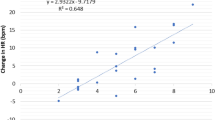Abstract
A total of 224 chronic pain somatoform disorder patients without obvious pathophysiology or psychopathology were found to have colder hands than nonpatients. A paradoxical temperature increase (PTI) in response to a cognitive stressor (mental arithmetic) was noted in a subset of these chronic pain patients. Patients were defined as “PTI” responders if, during cognitive stress, an increase in digital temperature occurred over a prior eyes closed resting condition. It was found that 49.4% of males and 42.6% of females in a total sample of 224 patients demonstrated PTI. The PTI patients had significantly colder hands than non-PTI patients prior to stress. A concurrent SCL measure of sympathetic activation found no difference between the PTI and non-PTI groups either at baseline or during cognitive stress. It appears from this data that PTI is specific to the peripheral vascular system of these patients and may be a marker of psychophysiological dissociation or trauma blocked from consciousness.
Similar content being viewed by others
REFERENCES
Aldrich, L. B., Moattari, A. R., & Vinik, A. (1988). Distinguishing features of idiopathic flushing and carcinoid syndrome. Archives of Internal Medicine, 148, 2614–2618.
American Psychiatric Association. (1987). Diagnostic and Statistical Manual of Mental Illness (3rd ed., rev.). Washington, DC: Author.
Arena J., & Hobbs S. (1993, March). Temporal Analysis of Psychophysiological Stress Profiles: A Re-Analysis using intra-class correlational coefficients. Paper presented at the Proceedings of the AAPB 24th Annual Meeting, Los Angeles, CA.
Barlow, D. H., & Cerny, J. A. (1988). Psychological Treatment of Panic. New York, London: Guilford Press.
Blanchard, E. B., Morrill, B., Wittrock, D. A., Scharff, L., & Jaccard, J. (1989). Hand Temperature Norms for Headache, Hypertension, and Irritable Bowel Syndrome. Biofeedback and Self-Regulation, 14(4), 319–331.
Blascovich, J., and Katkin, E. S. (Eds.). (1993). Cardiovascular reactivity to psychological stress and disease. Washington, DC: American Psychological Association.
Blomqvist, N. (1977). On the relation between change and initial value. Journal of the American Statistical Association, 72, 746–749.
Boucsein, W. (1992). Electrodermal Activity. New York: Plenum Press.
Cooke, J. P., Creager, M. A., Osmundson, P. J., & Shepherd, J. T. (1990). Sex Differences in Control of Cutaneous Blood Flow. Circulation, 82, 1607–1615.
Dantzer, R. (1991). Stress and disease: A psychobiological perspective, Annals of Behavioral Medicine, 13, 205–210.
Fowles, D. C., Christie, M. J., Edelberg, R., Grings, W. W., Lykken, D. T., & Venables, P. H. (1981). Publication recommendations for electrodermal measurements. Psychophysiology, 18, 232–239.
Frederickson, M., & Matthews, K. A. (1990). Cardiovascular responses to behavioral stress and hypertension: A meta-analytic review. Annals of Behavioral Medicine, 12(1), 30–39.
Halperin, J. L., Cohen, R. A., & Coffman, J. D. (1983). Digital vasodilation during mental stress in patients with Raynaud's disease. Cardiovascular Research, 17, 671–677.
Hayes, R. J. (1988). Methods for assessing whether change depends on initial value. Statistics in Medicine, 7, 915–927.
Hilgard, E. R. (1977). Divided Consciousness: Multiple Controls in Human Thought and Action. New York: Wiley.
Jennings, J. R., & McKnight, J. D. (1994). Inferring vagal tone from heart rate variability. Psychosomatic Medicine, 56, 194–196.
Kihlstrom, J. F. (1987). The cognitive unconscious. Science, 237, 1445–1452.
Lazarus, R. S. (1991). Emotion and adaptation. (pp. 235–237). New York: Oxford University Press.
Mason, J. W. (1972). Organization of psychoendocrine mechanisms: A review and reconsideration of research. In N. S. Greenfield & R. A. Sternbach (Eds.), Handbook of Psychophysiology (pp. 3–91). New York: Holt, Rinehart and Winston, Inc.
Naliboff, B. D., Benton, D., Solomon, G. F., Morley, J. E., Fahey, J. L., Bloom, E. T., Makinodan, T., & Gilmore, S. L. (1991). Immunological changes in the young and old adults during brief laboratory stress. Psychosomatic Medicine, 53, 121–132.
Rogers, C. R. (1951). Client centered therapy. Boston: Houghton-Mifflin.
Spiegel, D., Kluft, R. P., Loewenstein, R. J., Nemiah, J. C., Putnam, F. W., & Steinberg, M. (Eds.). (1993). Dissociative disorders: A clinical review. Lutherville, MD: Sidran Press
Taub, E. (1977). Self regulation of human tissue temperature. In G. E. Schwartz & J. Beatty (Eds.), Biofeedback: Theory and Research (pp. 265–300). New York: Academic Press.
Taub, E., & Emurian, C. S. (1976). Feedback-aided self-regulation of skin temperature with a single feedback locus. Biofeedback and Self-Regulation, 1, 147–168.
Wickramasekera, I. (1976). Biofeedback, Behavior Therapy and Hypnosis (pp. 99–100, 430–431). Chicago: Nelson Hall.
Wickramasekera, I. (1979). A model of the patient at high risk for chronic stress related disorders: Do beliefs have biological consequences? Paper presented at the annual convention of the Biofeedback Society of America, San Diego, CA.
Wickramasekera, I. (1983). A model of people at high risk. Paper read at the International Stress and Tension Control Society, Brighton, England.
Wickramasekera, I. (1986). A model of people at high risk to develop chronic stress related somatic symptoms: Some predictions. Professional Psychology: Research and Practice, 17(5), 437–447.
Wickramasekera, I. (1988). Clinical Behavioral Medicine: Some concepts and procedures. New York: Plenum.
Wickramasekera, I. (1993). Assessment and treatment of somatization disorders: The high risk model of threat perception. In S. Lynn, J. Rhue, I. Kirsch (Eds.). Handbook of Clinical Hypnosis (pp. 587–621). Washington, DC: American Psychological Association.
Wickramasekera, I. (1994). Somatic psychological symptoms and information transfer from implicit to explicit memory: A controlled case study with predictions from the High Risk Model of Threat Perception. Dissociation, 7(3), 153–166.
Wickramasekera, I., Pope, A., & Kolm, P. (1996). On the interaction of hypnotizability and negative affect in chronic pain: Implications for the somatization of trauma. J. Nervous and Mental Disease, 184(10), 628–635.
Wickramasekera, I., & Wickramasekera II, I. (1997). A case study: Electromyographic correlates in the hypnotic recall of a repressed memory. Dissociation. 10(1), 11–20.
Wickramasekera, I. (1998). Secrets kept from the mind but not the body or behavior: The unsolved problems of identifying and reating somatization and psychophysiological disease. Advances: The Journal of Mind-Body Medicine, 14(2), 81–98.
Author information
Authors and Affiliations
Rights and permissions
About this article
Cite this article
Wickramasekera, I.E., Kolm, P., Pope, A. et al. Observation of a Paradoxical Temperature Increase During Cognitive Stress in Some Chronic Pain Patients. Appl Psychophysiol Biofeedback 23, 233–241 (1998). https://doi.org/10.1023/A:1022261615117
Issue Date:
DOI: https://doi.org/10.1023/A:1022261615117




